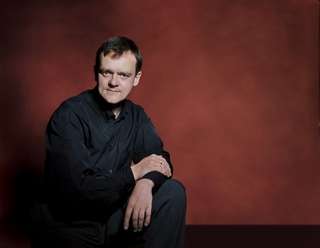|
Back
Mr. G’s M.O. New York
Avery Fisher Hall, Lincoln Center
09/24/2009 - & Sept. 25, 26
Johannes Brahms: Concerto in D major for Violin and Orchestra, Opus 77
Arnold Schoenberg: Pelleas und Melisande (after the Drama by Maurice Maeterlinck): Symphonic Poem for Orchestra, Opus 5
Frank Peter Zimmermann (Violin)
New York Philharmonic Orchestra, Alan Gilbert (Conductor)

Frank Peter Zimmermann (© Franz Hamm)
Alan Gilbert’s third concert as Musical Director of the New York Philharmonic has laid bare his adventurous modus operandi for the orchestra. First, he has no hesitation in throwing the most conservative audience members to the wolves, with works which push the musical envelope. His very first piece of the season was by Messiaen, this program had a second half devoted entirely to one rare work by Arnold Schoenberg.
And yes, a few dozen timid souls did walk out during the intermission (“Heavens! Music written only 104 years ago?? Disgraceful!”). Mr. Gilbert perhaps expected that, and to soften the blow, he presented the second part of this method of operating. His eight-minute lecture with musical illustrations was straightforward, personal (Mr. Gilbert offered his own theory of Mendelssohn’s influence) and informative.
Perhaps it didn’t do the trick for neophytes. For Pelleas und Melisande has a story which more detailed and literal than Transfigured Night. I have the audacity to suggest that in a work like this, the screen could be pulled down with different actions listed as they showed up in the music. I.e. “Melisande at the Well”, “Melisande Awakens To Love”, “Golaud Murders Pelleas” etc.
Then again, once Mr. Gilbert started conducting, those familiar with the story could have followed it faithfully. Those not enlightened would still have found a clear and lucid orchestral piece. For Mr. Gilbert obviously wanted this piece to show the most radiant colors, not to revert to the usual clotted rendition.
Schoenberg’s orchestration, while occasionally muddy (almost Tchaikovskyan in the most romantic sections) more often shines with brilliant ideas. Listening carefully, one hears the solo cello or solo clarinet announcing distorted love themes. Mr. Gilbert demonstrated the Ride Through the Forest, and when played, this was almost a hallucinogenic painting of trees branching out from each other.
Mr. Gilbert was very careful–perhaps too careful–not to let the emotions take hold of him. Mr. Gilbert evidently has very good taste. But in Schoenberg’s Pelleas–unlike the Fauré and Debussy versions–one would like to be drowned (or at least dunked) with some decadent swamp music.
Yet by the end, Mr. Gilbert produced from this dense score a work of atmosphere, spirit and, at times, the most gorgeous orchestral radiance.
Most of the audience had come to hear German violinist Frank Peter Zimmermann playing the Brahms Concerto, and they weren’t disappointed. Mr. Zimmermann has a reputation for thoughtful playing, and here he gave a demonstration of how straight violin playing with a flawless technique speaks for itself. He needed no exaggeration, no extra vibrato to give breadth to the opening movement, a brilliant cadenza, and then the start of the Adagio.
But at the apex of this movement, Mr. Zimmermann’s tone became so ravishing, so radiant, with such an ethereal glow that it was difficult to remember a more memorable sound. Yes, he was the artist, but I realized later that he had been playing that 1711 Stradivarius which had belonged to Fritz Kreisler.
The finale was played with the bite, humor and mastery which pleaded for–and received –an encore.
Later I heard somebody call Mr. Zimmermann’s instrument a “fiddle”. In the interests of good taste, I chose not to bludgeon him!
Harry Rolnick
|